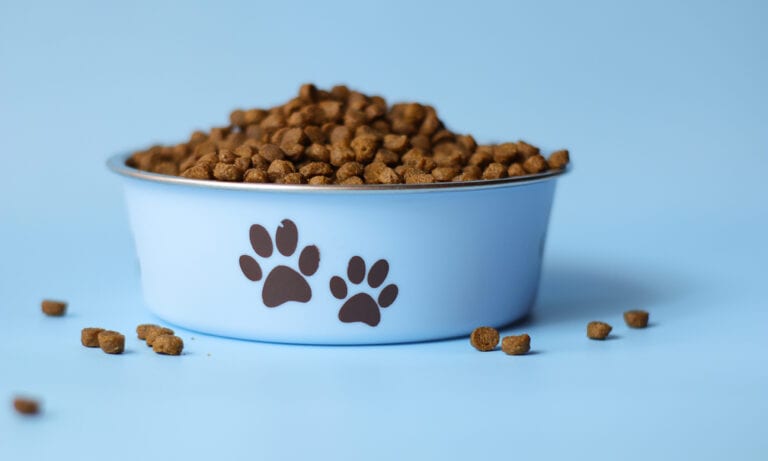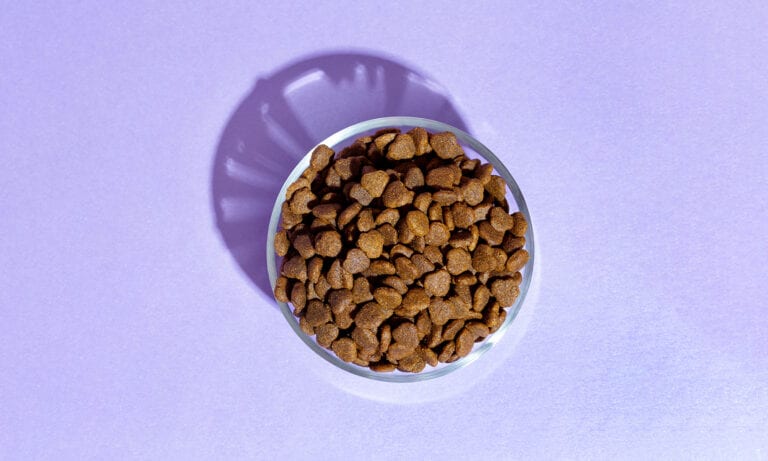If you’d like to encourage your pup to eat more of their dog food or want them to get more hydration, dog food toppers are an option to consider. While food toppers are primarily intended to enhance the palatability and nutrition of regular dog food, some can also double as a complete and balanced meal.
It’s important to understand what dog food toppers are and their benefits so you can choose the best dog food toppers for your pup’s specific needs. As always, be sure to check with your veterinarian before changing your pet’s diet.
What Are Dog Food Toppers?
While there’s no clear-cut definition of what constitutes dog food toppers, they are generally intended to be given as a diet enhancer or treat and, according to Dr. Zay Satchu, chief veterinary officer and co-founder of BondVet, based in New York City, are meant to be added to your dog’s food, typically dry food or kibble.
The key factor distinguishing a topper from regular dog food is its nutritional content. Dog foods should meet standards for a specific life stage—growth, adult maintenance, reproduction or a combination of these—set by the Association of American Feed Control Officials (AAFCO), says Dr. Jessica Romine, a veterinarian at Blue Pearl Veterinary Partners in Southfield, Michigan.
“Ideally, they will have completed feeding trials to confirm the diets are actually complete and balanced,” she says. “But—at a minimum—they should be formulated to meet these guidelines, and there has to be a statement on the packaging saying whether the diets meet these standards.”
Some dog food toppers, however, are designed to also serve as a whole meal. If it’s a balanced diet, the label will specify that it’s formulated to meet AAFCO standards for the given life stage. If the topper is strictly an enhancer, the label will read something like—“This product is intended for intermittent or supplemental feeding only,” says Dr. Romine, who is board-certified in veterinary internal medicine.
If a topper isn’t labeled as a complete and balanced food, veterinarians say it shouldn’t comprise more than about 10 percent of a dog’s diet.
Benefits of Dog Food Toppers
Dog food toppers are designed to make regular dog food taste better and can provide a nutritional boost, Dr. Coates says.
“Finicky eaters benefit the most from the use of toppers,” she says. “Not only can the topper itself provide a little nutritional boost, but it can also increase the amount of the regular diet that the dog takes in.”
They can especially be helpful for picky eaters who need a specific diet due to a health reason, “but who don’t find that particular diet palatable,” says Dr. Satchu. Others who can benefit are “ill dogs who need to be enticed to eat more or dogs who need a specific nutritional supplement that’s in a topper,” Dr. Satchu adds.
Dog food toppers can also be looked at as a treat.
“As long as a dog or cat is on a well-balanced diet, it can be viewed primarily as a way to give our pets a little exciting treat without completely changing the core diet they’re on,” says Dr. Romine.
Wet dog food toppers can also serve as a source of hydration, which your pet may need.
“For example, pets with kidney disease may benefit from the increased water content of wet food toppers,” Dr. Satchu says.
Some pets may also benefit from topper with a supplement added in. For example, “senior pets may benefit from a topper supplemented with glucosamine for arthritis,” Dr. Satchu says. “Of course, check with your veterinarian when choosing a topper for a medical benefit.”
Glucosamine isn’t the only supplement that can be included. “There are some toppers that may have supplemental proteins, omega-3 fatty acids and probiotics, for example, which can have more of a focus on improving skin health and coat condition, gut health or immune function,” says Dr. Romine.
Only toppers labeled as complete and balanced have all the necessary nutrients a dog needs, reminds Dr. Romine.
“So, I would not recommend using them to correct nutritional deficiencies,” she says. “The main diet is the place to ensure all these nutrients are provided.”
Types of Dog Food Toppers
Dog food toppers come in wet or dry formulations. Your choice of topper often boils down to personal preference (both your and your dog’s).
“Some people prefer the simplicity and easy storage of a dry topper, while others like to use a wet topper to moisten a dry kibble, and some dogs and cats love gravies,” Dr. Romine says.
Wet Dog Food Toppers
These include gravies, sauces and broths. Some wet dog food toppers will contain meat morsels, like in the top-rated Blue Buffalo Wilderness Trail Toppers Wild Cuts Chunky Beef in Hearty Gravy. Wet dog foods that are complete and balanced, like Tylee’s Human-Grade Beef Recipe Frozen Dog Food, can be used as dog food toppers as well.
One key benefit of wet dog food toppers, as noted above, is the hydration factor, which veterinarians say can be helpful if your dog needs more water in her diet.
(Another option for adding hydration to your dog’s diet is to switch to a canned food. “Switching to a canned food will increase a dog’s water consumption more than adding a topper to dry food,” says Dr. Jennifer Coates, a veterinary writer, editor and consultant based in Fort Collins, Colorado.)
Additionally, “a wet food topper can be easier to mix in with the base food, and more difficult for a finicky eater to pick out and separate from their base food,” Dr. Satchu says.
Dry Dog Food Toppers
Dry dog food toppers are formulated as powders or can come in freeze-dried, air-dried or dehydrated form.
“Dry toppers have the added benefit of easily being handed out as a treat,” Dr. Coates says.
A top-rated dry dog food tooper is Stella & Chewy’s Super Beef Meal Mixers, which contain freeze-dried nuggets that contain probiotics, antioxidants and nutrients from whole, raw ingredients.
Stewart Pro-Treat Freeze-Dried Beef Liver is also a highly rated product known for its enticing, pungent aroma. While these treats can be used for training, you can sprinkle the freeze-dried beef liver bites over your dog’s food to encourage your dog to eat.
So, what’s better? A dry dog food topper or wet dog food topper?
“Nutrition is less a matter of form than the ingredients used in the topper,” she says. "Even though toppers should make up just a small part of a dog's diet, it's still important to look for healthy ingredients like high-quality meats that add nutritional value to meals. Options that are free from artificial flavors, colors, and preservatives are ideal."
You may have to try a few out before you find one that works for you and your pup.
“Experimentation is probably the best way to see if there is one that really lights them up,” Dr. Romine says.
Top-Rated Dog Food Topper Brands
The best dog food toppers are those that can help you accomplish a specific goal, whether it’s to increase your dog’s hydration, encourage her to eat more of her regular food, or offer a tasty treat. Here are some of the top-rated dog food toppers to consider.
For multiple benefits, a product like Tylee’s Human-Grade Chicken Recipe Frozen Dog Food, can be used as a topper or served as a meal by itself.
It contains chicken, fruits and vegetables, as well as ingredients like chia seeds and sunflower oil, which are chocked full of omega-3 and -6 fatty acids that can aid in skin and coat health. And because it’s a wet topper, it has the added benefit of offering hydration. (Tylee’s also offers this product in beef, turkey and pork.)
Blue Buffalo Wilderness Trail Toppers Wild Cuts Chunky Salmon Bites (also available in beef, duck and chicken) is one of several dog food toppers for picky eaters. It is a wet topper but is specifically intended as a treat or enhancer and shouldn’t be considered a complete and balanced diet.
The Honest Kitchen Proper Toppers Grain-Free Turkey Recipe line (also available in chicken, fish or beef) features nutritionally dense, freeze-dried superfood clusters and can be served as a complete and balanced meal or topper.
Ask your veterinarian for brand recommendations, and “always be sure to tell your vet about any supplements and toppers you are giving your pet, because they influence nutritional plans,” Dr. Romine says.
Share:
















